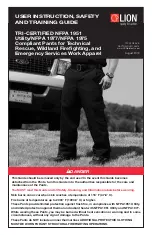
12
10.
USING YOUR PANTS SAFELY: HOW TO
MINIMIZE THE RISK OF INJURY
In addition to NFPA 1975, the Pants is designed in compliance with both
NFPA 1951 Utility and NFPA 1977 to protect the user against specific hazards
associated with technical rescue and wildland firefighting operations. This
section indicates the hazards associated with these activities, and specific
warnings concerning the proper safe usage of your Technical Rescue/Wildland
Firefighting Pants.
10.1
PREPARATION
Before beginning any Technical Rescue and/or Wildland Firefighting operation,
your Pants should be donned according to the procedures in Section 7 of this
Guide, and checked by an other person for proper interface.
10.2
BURN HAZARDS
There are three types of heat transfer: conduction, convection, and radiation.
Conduction is the direct transfer of heat through contact with a hot object.
Convection is the transfer of heat through a medium; for example, air. Thermal
radiation is the transfer of heat in the form of light energy, directly from flames or
reflected from hot surfaces.
FLASH FIRE
Flash fire means fire that rapidly spreads through a diffuse fuel, such as dust,
gas, or the vapors of an ignitable liquid, without the production of damaging
pressure. Flash fires mainly produce hazardous radiant heat, as well as
convective heat.
Always wear clean and thoroughly dry Pants. Soiled or contaminated Pants may be
combustible, causing serious burns to the wearer if exposed to a flash fire.
!
DANGER
Flash Fires are extremely dangerous incidents. The radiant and convective heat
produced by a flash fire may be severe enough that you may be burned even while
wearing these Pants, and without sustaining damage to the Pants. If you sense
combustible gases or debris in the area, you should escape to a safe area until the
dangerous condition has been eliminated.
!
DANGER
Always use this garment properly and in a manner consistent with the following:
•
The Authority Having Jurisdiction’s standard operating procedures;
•
NFPA 1500,
Standard on Fire Department Occupational Safety and Health Program
;
•
NFPA 1581,
Standard on Fire Department Infection Control Program
;
•
Title 29, Code of Federal Regulations (CFR), Part 1910.132 “General Requirements of Sub
part I, Personal Protective Equipment”; and
•
Title 29, CFR 1910.1030, “Protecting Health Care Workers from Occupational Exposure to
Blood-Borne Pathogens”
Do not continue to wear Tri-Certified Pants that have been exposed to products of combustion,
wash your pants as soon as possible after exposure to reduce contamination.
Summary of Contents for NFPA 1975
Page 22: ...22 NOTES...
























